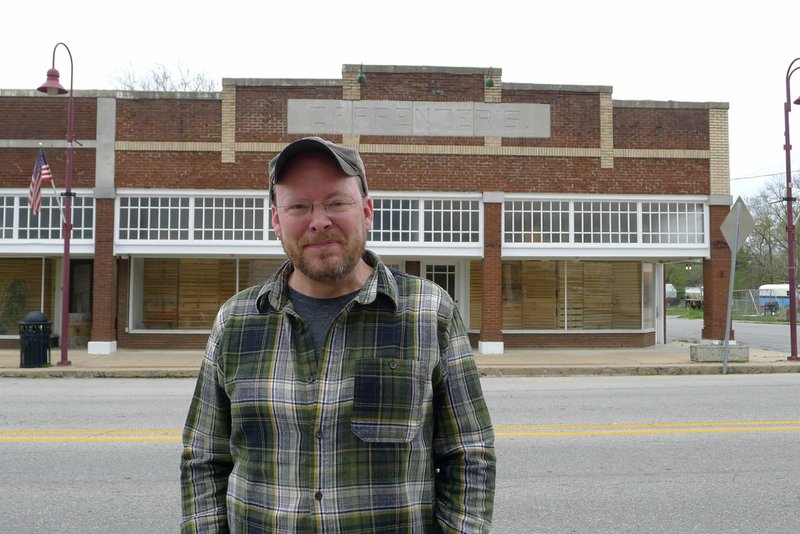GENTRY -- A former mortuary in Gentry will be nominated to the National Register of Historic Places along with 17 other places, including an art deco apartment building in Hot Springs and Johnny Cash's boyhood home at Dyess.
The state review board of the Arkansas Historic Preservation Program met Wednesday in Little Rock and approved all 18 properties under consideration, said Mark Christ, a spokesman for the program.
Christ said the board should hear back from the National Park Service within two months. He said at least 98 percent of the properties nominated by the board make the National Register, which is the official list of the nation's historic places worthy of preservation.
The Carpenter Building in Gentry is a single-story commercial building constructed of brick and hollow clay tile, according to the nomination form written by Charlie Bookout, one of the building's owners.
The craftsman-style building is home to Mortuary Studios, where Bookout and the other four owners work on creative projects, including art, music and film.
While it may look like urban art space from the inside, "we always called ourselves a rural art studio," Bookout said.
Every October, the building also serves as Carpenter's Mortuary Spook House, which attracts between 2,000 and 3,000 children for Halloween screams.
The building was designed by Albert Oscar "A.O." Clarke, a well-known Arkansas architect who designed the two largest log buildings in the world at Monte Ne, a resort that's now beneath Beaver Lake.
Clarke designed at least 27 structures in Benton, Carroll and Washington counties, including the Benton County Courthouse in Bentonville.
The Carpenter Building was constructed from 1927 to 1929. Initially, the building housed a furniture store and grocery store in front along Main Street, and a mortuary in the back.
"The mortuary space included an embalming room, funeral parlor, chapel, and office space in the set of rooms that run along the entire rear of the building," according to the nomination. "The building has survived amazingly intact with only a few alterations since its construction."
The Cleveland Arms Apartment Building at 2410 Central Ave. in Hot Springs was built around 1945. The building is three stories on one side and two on the other.
"The buff-colored brick building is a good example of simple Art Moderne Style architecture with Art Deco detailing," according to the nomination written by Toni Johnson of Little Rock.
Cleveland Arms is the smaller sister building to Cleveland Manor Apartments, which is a few blocks north on Central Avenue.
"They were built with Federal Housing Authority funds, by the same owner, to answer the call for additional affordable housing for returning World War II veterans," Johnson wrote.
Cleveland Arms was designed for officers and their families while Cleveland Manor housed enlisted men, wrote Johnson.
The apartments were all two-bedroom units with one bathroom, a living room, dining room, and kitchen. The building was originally designed to hold 16 families. A car park that accommodated 10 cars was demolished last year.
Cleveland Arms, which is currently empty, has undergone very few alterations and retains its historic integrity, according to the nomination.
Cash's boyhood home was rejected by the National Register in February. The board was urged to resubmit the nomination to focus on the influence that Cash's early years in Arkansas had on his musical career.
If the board can demonstrate that the New Deal-era, five-room farmhouse at Dyess in Mississippi County had a "profound impact" on Cash's formative years, then it can be listed on the National Register, Jim Gabbert, a historian who reviewed the nomination for the National Register, wrote in his comments to the board.
Cash lived in the house at Dyess from the age of 3 through high school.
Cash's boyhood home is also being considered for its architectural significance.
Other Arkansas properties that are being nominated include:
• Deepwood House at Fayetteville in Washington County
• Prairie Grove Commercial Historic District in Washington County
• North Mock Street Commercial Historic District at Prairie Grove
• Mosaic Templars State Temple at Little Rock in Pulaski County
• Eureka Springs Cemetery at Eureka Springs in Carroll County
• Goodwin Field Administration Building at El Dorado in Union County
• Fulk-Arkansas Democrat Building in Little Rock
• Carmichael House in the Landmark community in Pulaski County
• Nevada County Courthouse at Prescott
• Washington Street Historic District Boundary Increase at Camden in Ouachita County
• Schumaker Naval Ammunition Depot Barracks Buildings and Schumaker Naval Ammunition Depot Administration Building at East Camden in Calhoun County
• Mount Salem Church and School near Paris in Logan County
• C.A. Stuck and Sons Lumber Office Building at Jonesboro in Craighead County
• Lockesburg Gymnasium at Lockesburg in Sevier County.
The board meets three times a year and usually nominates eight to 15 properties for the National Register.
The board also listed six properties on the Arkansas Register of Historic Places: Ellis Building at Fayetteville, Harrell Cemetery near Cincinnati in Washington County, Lines Cemetery near Preston in Faulkner County, Petit Jean Mountain Cemetery near Winrock in Conway County, Dierks Lumber Co. Building at Mountain Pine in Garland County and Schumaker Naval Ammunition Depot Laundry Building at East Camden in Calhoun County.
The Arkansas Register recognizes historically significant properties that don't meet the National Register requirements.
NW News on 04/09/2018
